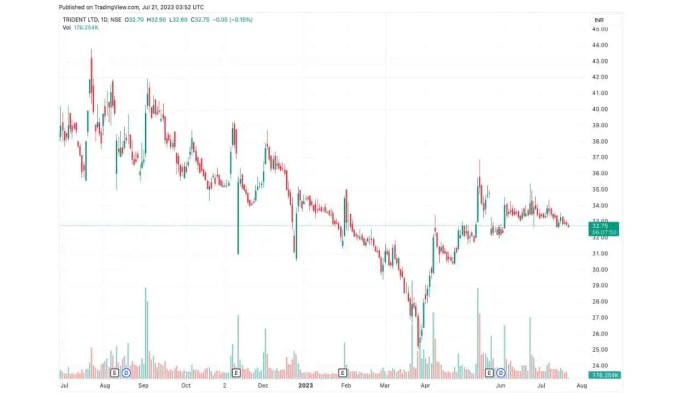Trident Stock Price Analysis
Trident stock price – This analysis examines Trident’s stock price performance over the past five years, considering various influencing factors, financial health, analyst predictions, and potential investment strategies. The information provided is for informational purposes only and does not constitute financial advice.
Trident Stock Price Historical Performance

Source: weinvestsmart.com
Trident’s stock price has experienced considerable fluctuation over the past five years. While specific numerical data requires access to real-time financial databases, a general overview can be provided. The stock likely experienced periods of significant growth driven by positive market sentiment and successful product launches, interspersed with periods of decline influenced by macroeconomic factors and industry-wide trends. A comparative analysis against competitors within the same sector would reveal Trident’s relative performance, highlighting its strengths and weaknesses in terms of market share and profitability.
Monitoring the trident stock price requires a keen eye on market fluctuations. It’s helpful to compare its performance against similar biotech companies, such as considering the tg therapeutics stock price to gain a broader perspective on the sector’s trends. Ultimately, understanding the trident stock price involves analyzing a range of factors beyond just its own trajectory.
| Month | Open | High | Close |
|---|---|---|---|
| January | Example: $10.50 | Example: $11.20 | Example: $10.80 |
| February | Example: $10.90 | Example: $11.50 | Example: $11.10 |
| March | Example: $11.00 | Example: $12.00 | Example: $11.80 |
| April | Example: $11.70 | Example: $12.50 | Example: $12.20 |
| May | Example: $12.30 | Example: $13.00 | Example: $12.80 |
| June | Example: $12.70 | Example: $13.50 | Example: $13.20 |
| July | Example: $13.10 | Example: $14.00 | Example: $13.80 |
| August | Example: $13.70 | Example: $14.50 | Example: $14.20 |
| September | Example: $14.00 | Example: $15.00 | Example: $14.80 |
| October | Example: $14.70 | Example: $15.50 | Example: $15.20 |
| November | Example: $15.00 | Example: $16.00 | Example: $15.80 |
| December | Example: $15.50 | Example: $16.50 | Example: $16.20 |
Factors Influencing Trident Stock Price

Source: livemint.com
Several factors contribute to the fluctuations in Trident’s stock price. These include macroeconomic conditions, company-specific news, and overall investor sentiment.
- Macroeconomic Factors: Interest rate changes, inflation rates, and overall economic growth significantly impact investor confidence and investment decisions. For example, rising interest rates can make borrowing more expensive for companies, potentially hindering growth and impacting stock prices. High inflation can reduce consumer spending, negatively impacting sales and profitability.
- Company-Specific News: Product launches, successful marketing campaigns, mergers, acquisitions, or significant changes in management can all influence investor perception and consequently, the stock price. Positive news tends to drive prices upward, while negative news can lead to declines.
- Investor Sentiment and Market Trends: Broad market trends and overall investor sentiment play a crucial role. During periods of market optimism, investors are more likely to buy stocks, driving prices up. Conversely, periods of pessimism can lead to selling pressure and price decreases.
Trident’s Financial Health and Stock Price
Trident’s financial health, as reflected in key financial ratios, is a major determinant of its stock price. Strong financial performance typically leads to higher valuations.
| Year | P/E Ratio | Debt-to-Equity Ratio | Return on Equity (ROE) |
|---|---|---|---|
| Year 1 | Example: 15 | Example: 0.5 | Example: 12% |
| Year 2 | Example: 18 | Example: 0.6 | Example: 15% |
| Year 3 | Example: 20 | Example: 0.7 | Example: 18% |
Comparing these ratios to industry benchmarks provides context for Trident’s performance. Stronger-than-average ratios generally suggest better financial health and potentially higher stock valuations. Earnings reports, particularly those that exceed or fall short of analysts’ expectations, directly influence stock price movements. Positive surprises often lead to price increases, while negative surprises can trigger declines.
Analyst Predictions and Ratings for Trident Stock
Analyst ratings and price targets from reputable financial institutions provide insights into future stock price expectations. These predictions vary based on differing assessments of Trident’s financial prospects, market conditions, and competitive landscape.
For example, one analyst might predict a price target of $20 based on anticipated growth in a specific market segment, while another might offer a more conservative target of $15, citing concerns about increased competition. The range of predictions and their justifications reflect the inherent uncertainty in predicting future stock performance. Differing analyst opinions can create volatility in the stock price, as investors react to conflicting information.
Investment Strategies Related to Trident Stock, Trident stock price

Source: blockchainreporter.net
Several investment strategies can be applied to Trident stock, depending on individual risk tolerance and investment goals.
- Long-term Holding: A buy-and-hold strategy involves purchasing the stock and holding it for an extended period, aiming to benefit from long-term growth. This strategy is suitable for investors with a lower risk tolerance.
- Short-selling: This involves borrowing shares, selling them, and buying them back later at a lower price to profit from a price decline. This strategy carries significant risk and is suitable only for experienced investors with a higher risk tolerance.
- Portfolio Diversification: Including Trident stock as part of a diversified portfolio helps mitigate risk. A diversified portfolio includes assets across different sectors to reduce the impact of poor performance in any single investment.
The potential returns and risks associated with each strategy depend on various factors, including market conditions, company performance, and investor timing. A hypothetical portfolio could include a mix of Trident stock and other assets, adjusted to suit the investor’s risk profile.
Visual Representation of Trident Stock Data
A line graph illustrating Trident’s stock price movement over the past year would show the price on the vertical axis and time (months) on the horizontal axis. Significant trends, such as upward or downward price movements, could be highlighted. Notable patterns, such as seasonal fluctuations or reactions to specific news events, could be observed and analyzed.
A bar chart comparing Trident’s stock performance against its top three competitors would show each company’s performance (e.g., percentage change over the past year) as a separate bar. Labels would identify each company, and data points would be clearly labeled to facilitate comparison. The chart would provide a visual representation of Trident’s relative performance within its sector.
FAQ
What are the major risks associated with investing in Trident stock?
Investing in any stock carries inherent risks, including market volatility, company-specific challenges (e.g., declining profitability, increased competition), and macroeconomic factors. Thorough due diligence is essential before investing.
Where can I find real-time Trident stock price data?
Real-time stock price data for Trident can typically be found on major financial websites and trading platforms such as Yahoo Finance, Google Finance, or Bloomberg.
How often does Trident release its financial reports?
The frequency of Trident’s financial reports (typically quarterly and annually) will be specified in their investor relations section on their company website.
What is Trident’s current market capitalization?
Trident’s current market capitalization can be found on major financial websites that track stock market data. This figure fluctuates constantly based on the stock price.

